Jungseul Ok
Improving Generative Behavior Cloning via Self-Guidance and Adaptive Chunking
Oct 14, 2025Abstract:Generative Behavior Cloning (GBC) is a simple yet effective framework for robot learning, particularly in multi-task settings. Recent GBC methods often employ diffusion policies with open-loop (OL) control, where actions are generated via a diffusion process and executed in multi-step chunks without replanning. While this approach has demonstrated strong success rates and generalization, its inherent stochasticity can result in erroneous action sampling, occasionally leading to unexpected task failures. Moreover, OL control suffers from delayed responses, which can degrade performance in noisy or dynamic environments. To address these limitations, we propose two novel techniques to enhance the consistency and reactivity of diffusion policies: (1) self-guidance, which improves action fidelity by leveraging past observations and implicitly promoting future-aware behavior; and (2) adaptive chunking, which selectively updates action sequences when the benefits of reactivity outweigh the need for temporal consistency. Extensive experiments show that our approach substantially improves GBC performance across a wide range of simulated and real-world robotic manipulation tasks. Our code is available at https://github.com/junhyukso/SGAC
Delving into Instance-Dependent Label Noise in Graph Data: A Comprehensive Study and Benchmark
Jun 14, 2025Abstract:Graph Neural Networks (GNNs) have achieved state-of-the-art performance in node classification tasks but struggle with label noise in real-world data. Existing studies on graph learning with label noise commonly rely on class-dependent label noise, overlooking the complexities of instance-dependent noise and falling short of capturing real-world corruption patterns. We introduce BeGIN (Benchmarking for Graphs with Instance-dependent Noise), a new benchmark that provides realistic graph datasets with various noise types and comprehensively evaluates noise-handling strategies across GNN architectures, noisy label detection, and noise-robust learning. To simulate instance-dependent corruptions, BeGIN introduces algorithmic methods and LLM-based simulations. Our experiments reveal the challenges of instance-dependent noise, particularly LLM-based corruption, and underscore the importance of node-specific parameterization to enhance GNN robustness. By comprehensively evaluating noise-handling strategies, BeGIN provides insights into their effectiveness, efficiency, and key performance factors. We expect that BeGIN will serve as a valuable resource for advancing research on label noise in graphs and fostering the development of robust GNN training methods. The code is available at https://github.com/kimsu55/BeGIN.
* 17 pages
DeRAGEC: Denoising Named Entity Candidates with Synthetic Rationale for ASR Error Correction
Jun 09, 2025
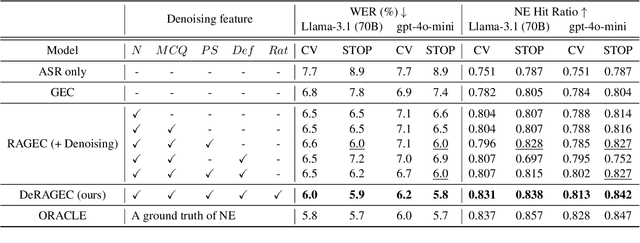

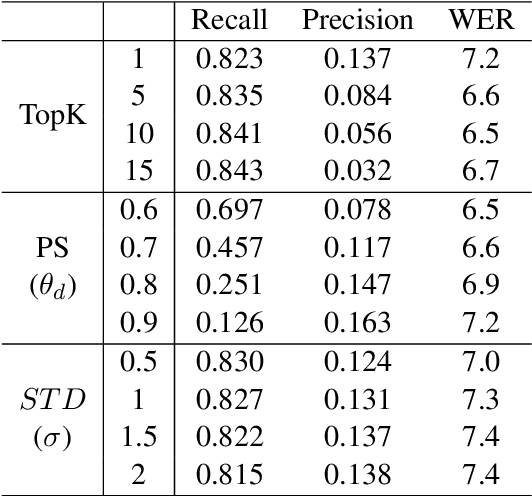
Abstract:We present DeRAGEC, a method for improving Named Entity (NE) correction in Automatic Speech Recognition (ASR) systems. By extending the Retrieval-Augmented Generative Error Correction (RAGEC) framework, DeRAGEC employs synthetic denoising rationales to filter out noisy NE candidates before correction. By leveraging phonetic similarity and augmented definitions, it refines noisy retrieved NEs using in-context learning, requiring no additional training. Experimental results on CommonVoice and STOP datasets show significant improvements in Word Error Rate (WER) and NE hit ratio, outperforming baseline ASR and RAGEC methods. Specifically, we achieved a 28% relative reduction in WER compared to ASR without postprocessing. Our source code is publicly available at: https://github.com/solee0022/deragec
Influence Functions for Edge Edits in Non-Convex Graph Neural Networks
Jun 05, 2025Abstract:Understanding how individual edges influence the behavior of graph neural networks (GNNs) is essential for improving their interpretability and robustness. Graph influence functions have emerged as promising tools to efficiently estimate the effects of edge deletions without retraining. However, existing influence prediction methods rely on strict convexity assumptions, exclusively consider the influence of edge deletions while disregarding edge insertions, and fail to capture changes in message propagation caused by these modifications. In this work, we propose a proximal Bregman response function specifically tailored for GNNs, relaxing the convexity requirement and enabling accurate influence prediction for standard neural network architectures. Furthermore, our method explicitly accounts for message propagation effects and extends influence prediction to both edge deletions and insertions in a principled way. Experiments with real-world datasets demonstrate accurate influence predictions for different characteristics of GNNs. We further demonstrate that the influence function is versatile in applications such as graph rewiring and adversarial attacks.
Don't Just Follow MLLM Plans: Robust and Efficient Planning for Open-world Agents
May 30, 2025Abstract:Developing autonomous agents capable of mastering complex, multi-step tasks in unpredictable, interactive environments presents a significant challenge. While Large Language Models (LLMs) offer promise for planning, existing approaches often rely on problematic internal knowledge or make unrealistic environmental assumptions. Although recent work explores learning planning knowledge, they still retain limitations due to partial reliance on external knowledge or impractical setups. Indeed, prior research has largely overlooked developing agents capable of acquiring planning knowledge from scratch, directly in realistic settings. While realizing this capability is necessary, it presents significant challenges, primarily achieving robustness given the substantial risk of incorporating LLMs' inaccurate knowledge. Moreover, efficiency is crucial for practicality as learning can demand prohibitive exploration. In response, we introduce Robust and Efficient Planning for Open-world Agents (REPOA), a novel framework designed to tackle these issues. REPOA features three key components: adaptive dependency learning and fine-grained failure-aware operation memory to enhance robustness to knowledge inaccuracies, and difficulty-based exploration to improve learning efficiency. Our evaluation in two established open-world testbeds demonstrates REPOA's robust and efficient planning, showcasing its capability to successfully obtain challenging late-game items that were beyond the reach of prior approaches.
Self-Training Large Language Models with Confident Reasoning
May 23, 2025Abstract:Large language models (LLMs) have shown impressive performance by generating reasoning paths before final answers, but learning such a reasoning path requires costly human supervision. To address this issue, recent studies have explored self-training methods that improve reasoning capabilities using pseudo-labels generated by the LLMs themselves. Among these, confidence-based self-training fine-tunes LLMs to prefer reasoning paths with high-confidence answers, where confidence is estimated via majority voting. However, such methods exclusively focus on the quality of the final answer and may ignore the quality of the reasoning paths, as even an incorrect reasoning path leads to a correct answer by chance. Instead, we advocate the use of reasoning-level confidence to identify high-quality reasoning paths for self-training, supported by our empirical observations. We then propose a new self-training method, CORE-PO, that fine-tunes LLMs to prefer high-COnfidence REasoning paths through Policy Optimization. Our experiments show that CORE-PO improves the accuracy of outputs on four in-distribution and two out-of-distribution benchmarks, compared to existing self-training methods.
MiLQ: Benchmarking IR Models for Bilingual Web Search with Mixed Language Queries
May 22, 2025



Abstract:Despite bilingual speakers frequently using mixed-language queries in web searches, Information Retrieval (IR) research on them remains scarce. To address this, we introduce MiLQ,Mixed-Language Query test set, the first public benchmark of mixed-language queries, confirmed as realistic and highly preferred. Experiments show that multilingual IR models perform moderately on MiLQ and inconsistently across native, English, and mixed-language queries, also suggesting code-switched training data's potential for robust IR models handling such queries. Meanwhile, intentional English mixing in queries proves an effective strategy for bilinguals searching English documents, which our analysis attributes to enhanced token matching compared to native queries.
Revisiting Early Detection of Sexual Predators via Turn-level Optimization
Mar 09, 2025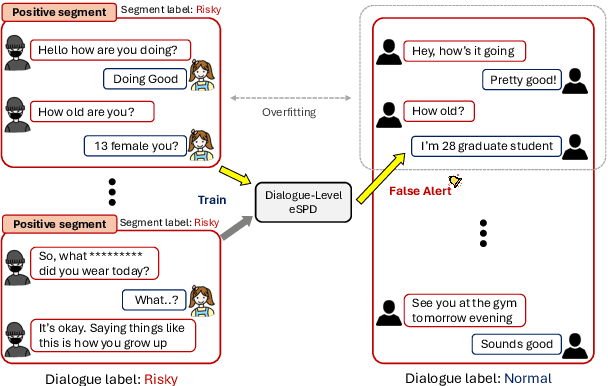



Abstract:Online grooming is a severe social threat where sexual predators gradually entrap child victims with subtle and gradual manipulation. Therefore, timely intervention for online grooming is critical for proactive protection. However, previous methods fail to determine the optimal intervention points (i.e., jump to conclusions) as they rely on chat-level risk labels by causing weak supervision of risky utterances. For timely detection, we propose speed control reinforcement learning (SCoRL) (The code and supplementary materials are available at https://github.com/jinmyeongAN/SCoRL), incorporating a practical strategy derived from luring communication theory (LCT). To capture the predator's turn-level entrapment, we use a turn-level risk label based on the LCT. Then, we design a novel speed control reward function that balances the trade-off between speed and accuracy based on turn-level risk label; thus, SCoRL can identify the optimal intervention moment. In addition, we introduce a turn-level metric for precise evaluation, identifying limitations in previously used chat-level metrics. Experimental results show that SCoRL effectively preempted online grooming, offering a more proactive and timely solution. Further analysis reveals that our method enhances performance while intuitively identifying optimal early intervention points.
CoPL: Collaborative Preference Learning for Personalizing LLMs
Mar 03, 2025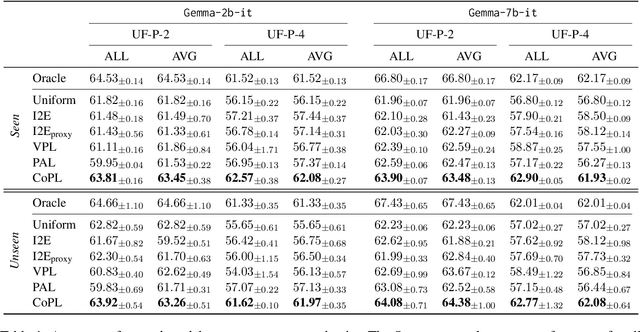


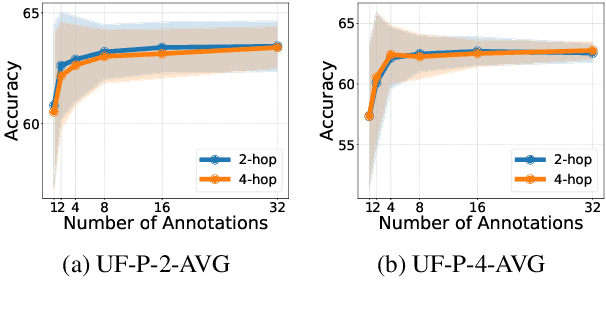
Abstract:Personalizing large language models (LLMs) is important for aligning outputs with diverse user preferences, yet existing methods struggle with flexibility and generalization. We propose CoPL (Collaborative Preference Learning), a graph-based collaborative filtering framework that models user-response relationships to enhance preference estimation, particularly in sparse annotation settings. By integrating a mixture of LoRA experts, CoPL efficiently fine-tunes LLMs while dynamically balancing shared and user-specific preferences. Additionally, an optimization-free adaptation strategy enables generalization to unseen users without fine-tuning. Experiments on UltraFeedback-P demonstrate that CoPL outperforms existing personalized reward models, effectively capturing both common and controversial preferences, making it a scalable solution for personalized LLM alignment.
Enhancing Cost Efficiency in Active Learning with Candidate Set Query
Feb 10, 2025

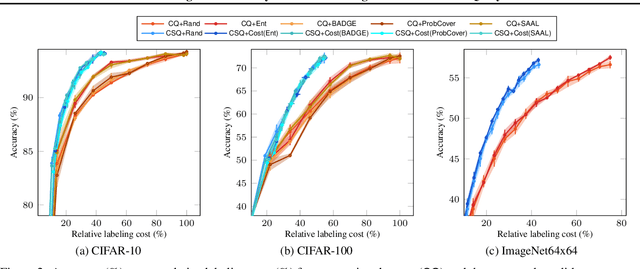
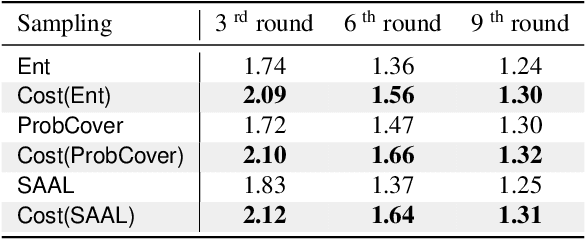
Abstract:This paper introduces a cost-efficient active learning (AL) framework for classification, featuring a novel query design called candidate set query. Unlike traditional AL queries requiring the oracle to examine all possible classes, our method narrows down the set of candidate classes likely to include the ground-truth class, significantly reducing the search space and labeling cost. Moreover, we leverage conformal prediction to dynamically generate small yet reliable candidate sets, adapting to model enhancement over successive AL rounds. To this end, we introduce an acquisition function designed to prioritize data points that offer high information gain at lower cost. Empirical evaluations on CIFAR-10, CIFAR-100, and ImageNet64x64 demonstrate the effectiveness and scalability of our framework. Notably, it reduces labeling cost by 42% on ImageNet64x64.
 Add to Chrome
Add to Chrome Add to Firefox
Add to Firefox Add to Edge
Add to Edge